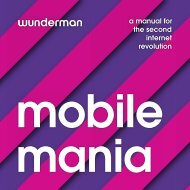My Brain hurts - Wunderman books
My Brain hurts - Wunderman books
My Brain hurts - Wunderman books
Create successful ePaper yourself
Turn your PDF publications into a flip-book with our unique Google optimized e-Paper software.
1. THINK SIMPLE<br />
‘When I listen to music, I like to hum along<br />
and tap my feet’, they told him. ‘If other<br />
people can’t hear the music I’m doing it<br />
to, they’ll think I’m a psycho.’<br />
To communicate the idea, he needed a product<br />
that could be understood in one way only.<br />
And that meant it had to have one function only. The<br />
record button and radio had to go.<br />
So he overruled the engineers. And his one-function<br />
press and play device went into production.<br />
Because his new product could only be used in one way,<br />
young people were forced to take Morita’s intention<br />
seriously.<br />
Simplicity acts like a<br />
missile into the<br />
consumer<br />
consciousness.<br />
If you want to get inside the<br />
consumer’s head, simplicity<br />
is the key.<br />
In the late 1970s, Sony was developing a new consumer<br />
electronics device.<br />
The device would allow people, for the first time ever, to<br />
carry round music easily and listen to it anywhere<br />
without irritating others.<br />
The device was designed to do this – and nothing else.<br />
‘But they will still want a record function’, said the<br />
engineers, ‘and how about a radio?’<br />
But Akio Morita, the founder of Sony, knew that he had<br />
a serious communication problem on his hands.<br />
At the time, young people always shared music,<br />
wandering around in groups with throbbing ghettoblasters.<br />
He was asking them to wander around listening to<br />
music that no one else could hear. He knew they would<br />
find the concept weird, and would resist the idea.<br />
This forced the Walkman into the public consciousness,<br />
and made it a worldwide hit.<br />
‘The ideal<br />
consumer<br />
electronics<br />
device has only<br />
one button.’<br />
AKIO MORITA,<br />
FOUNDER OF SONY<br />
Which means<br />
A device that does one thing well is a much stronger<br />
consumer proposition than a complex multifunctional<br />
offer, no matter how advanced its specification.<br />
So if you want to get inside the consumer’s head, think<br />
simple.<br />
1. Simplicity gets remembered<br />
In the 1960s, offices flooded with new technology –<br />
duplicating machines, golf-ball typewriters, telexes and<br />
more.<br />
But the only machine in that office with one-button<br />
simplicity was the photocopier.<br />
Most companies that made office equipment in the<br />
1960s are now footnotes in history.<br />
Even government can be<br />
simple. Clinton’s 1992 election<br />
team pinned these words to<br />
their hotel room doors.<br />
14 WUNDERMAN<br />
MY BRAIN HURTS 15




